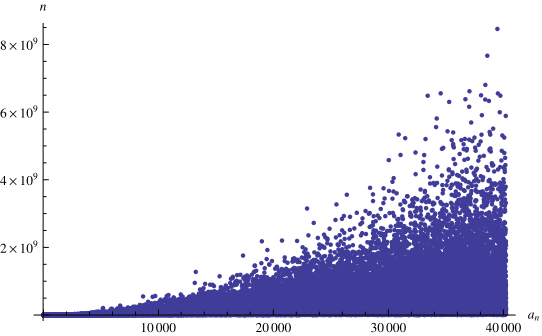The continued fraction for is [0; 1, 2, 3, 1, 6, 3, 1, 1, 2, 1, 1, 1, 1, 3, 10, ...]
(OEIS A016730).
The Engel expansion is 2, 3, 7, 9, 104, 510, 1413, ... (OEIS A059180).
The incrementally largest terms in the continued fraction of are 2, 3, 6, 26, 716, 774, 982, 1324, 4093, 10322, ...
(OEIS A228346), which occur at positions 0,
1, 7, 17, 30, 136, 962, 1163, 1261, 1293, ... (OEIS A228345).

The plot above shows the positions of the first occurrences of 1, 2, 3, ... in the continued fraction, the first few of which are 4, 0, 1, 11, 18, 7, 44, 159, 74, 212,
260, 182, 43, 152, 59, 84, 40, 86, 27, 89, ... (OEIS A228270).
The smallest number not occurring in the first terms of the continued fraction are 40230, 45952,
46178, 46530, ... (E. Weisstein, Aug. 18, 2013).
Let the continued fraction of be denoted
and let the denominators of the convergents
be denoted
,
, ...,
. Then plots above show successive values of
,
,
, which appear to converge to Khinchin's
constant (left figure) and
, which appear to converge to the Lévy
constant (right figure), although neither of these limits has been rigorously
established.